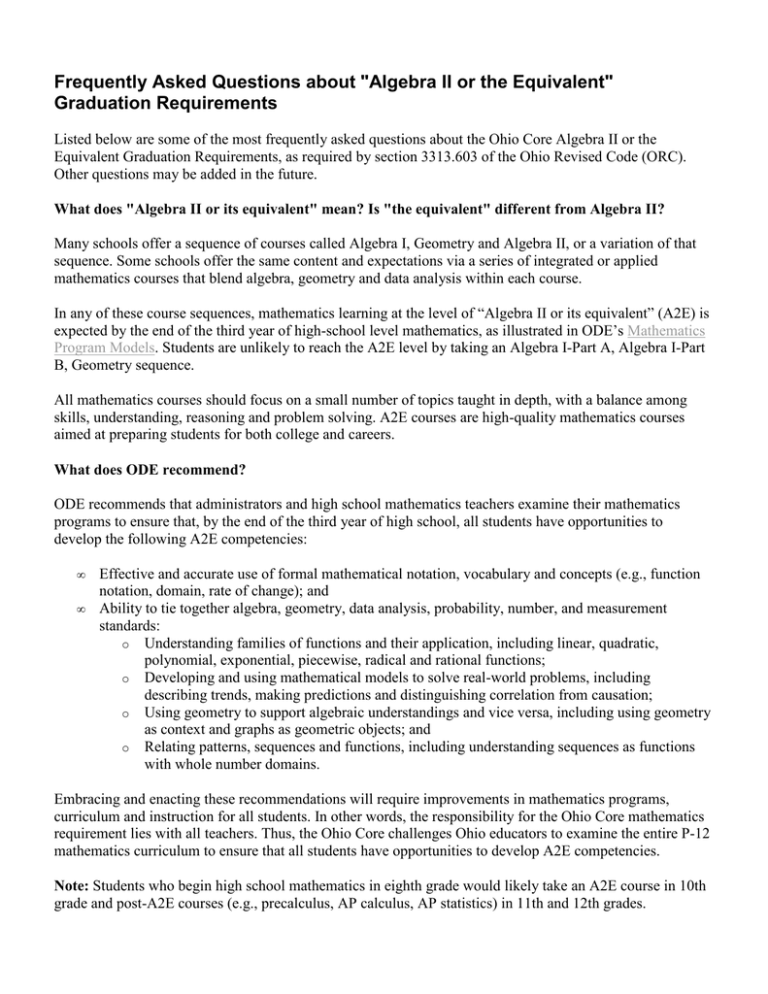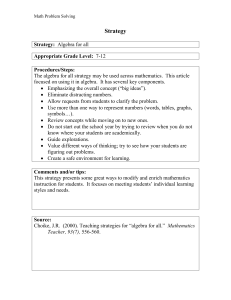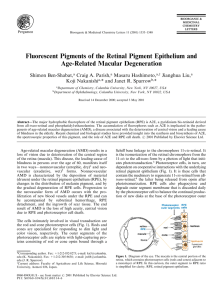Core Curriculum Algebra II Requirements FAQ
advertisement

Frequently Asked Questions about "Algebra II or the Equivalent" Graduation Requirements Listed below are some of the most frequently asked questions about the Ohio Core Algebra II or the Equivalent Graduation Requirements, as required by section 3313.603 of the Ohio Revised Code (ORC). Other questions may be added in the future. What does "Algebra II or its equivalent" mean? Is "the equivalent" different from Algebra II? Many schools offer a sequence of courses called Algebra I, Geometry and Algebra II, or a variation of that sequence. Some schools offer the same content and expectations via a series of integrated or applied mathematics courses that blend algebra, geometry and data analysis within each course. In any of these course sequences, mathematics learning at the level of “Algebra II or its equivalent” (A2E) is expected by the end of the third year of high-school level mathematics, as illustrated in ODE’s Mathematics Program Models. Students are unlikely to reach the A2E level by taking an Algebra I-Part A, Algebra I-Part B, Geometry sequence. All mathematics courses should focus on a small number of topics taught in depth, with a balance among skills, understanding, reasoning and problem solving. A2E courses are high-quality mathematics courses aimed at preparing students for both college and careers. What does ODE recommend? ODE recommends that administrators and high school mathematics teachers examine their mathematics programs to ensure that, by the end of the third year of high school, all students have opportunities to develop the following A2E competencies: • • Effective and accurate use of formal mathematical notation, vocabulary and concepts (e.g., function notation, domain, rate of change); and Ability to tie together algebra, geometry, data analysis, probability, number, and measurement standards: o Understanding families of functions and their application, including linear, quadratic, polynomial, exponential, piecewise, radical and rational functions; o Developing and using mathematical models to solve real-world problems, including describing trends, making predictions and distinguishing correlation from causation; o Using geometry to support algebraic understandings and vice versa, including using geometry as context and graphs as geometric objects; and o Relating patterns, sequences and functions, including understanding sequences as functions with whole number domains. Embracing and enacting these recommendations will require improvements in mathematics programs, curriculum and instruction for all students. In other words, the responsibility for the Ohio Core mathematics requirement lies with all teachers. Thus, the Ohio Core challenges Ohio educators to examine the entire P-12 mathematics curriculum to ensure that all students have opportunities to develop A2E competencies. Note: Students who begin high school mathematics in eighth grade would likely take an A2E course in 10th grade and post-A2E courses (e.g., precalculus, AP calculus, AP statistics) in 11th and 12th grades.



